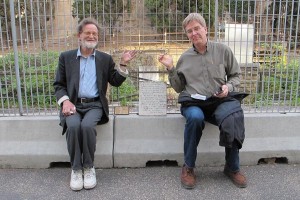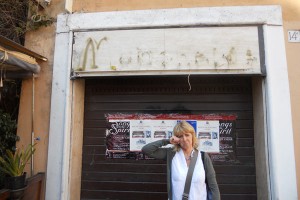
I spent the afternoon in my hotel room, splicing all the little changes and discoveries into what will be the 2012 edition of my Rick Steves’ Rome guidebook. Stepping out for just a quick little break is dangerous. There’s a mean current here and, turning the corner from my hotel, I got swept out into the Roman sea ‘ so filled with colorful and fragrant distractions. I didn’t get back for hours. It really was like swimming in a current.
Tiny black cobbles slope downhill to the ancient street level at the Pantheon’s portico. From there, I look up at a symphony of images: designer shades and flowing hair glinting and backlit in the magic-hour sun; a flute section of ice-cream-lickers sitting on their marble bench in the spritz of the fountain under the obelisk exclamation point; strolling Romanian accordion players who refuse to follow the conductor; and the stains of a golden arch on a wall marking where a McDonald’s once sold fast food, as if to celebrate its demise. The entire scene is corralled by pastel walls ‘ providing the visual equivalent of good acoustics.
As I let go of the Pantheon’s Egyptian columns, the current sweeps me past siren cafés, past the TV news crew covering something big in front of the parliament building, and out into Via Cavour. This is the deep end, which hosts the rough crowd from the suburbs who come in to the center for some cityscape elegance and concrete-people friendliness. They’ve gooped on a little extra grease and are wearing their best leggings, heels, and T-shirts.
Veering away from the busy pedestrian boulevard, I come upon Fausto, a mad artist standing proudly amid his installation of absurdities. While crazy, he always seems strangely sane in this world. And this year, with the opening of the giant and trying-too-hard MAXXI modern art gallery (11 years and 150 million euros for very little), Fausto seems downright brilliant. He’s the only street artist I’ve met who personally greets viewers. After surveying his tiny gallery of hand-scrawled and thought-provoking tidbits lined along a curb, I ask for a card. Giving me a handmade piece of wallet-sized art, he reminds me his “secretary” is at the end of the curb ‘ a plastic piggy bank for tips.
The Campo de’ Fiori, which creates its own current, feels like a punished child. Just last week, after a Roman teenager drank herself into a coma, the police forbade drinking outside of bars and restaurants ‘ and now it’s like someone turned on the lights at a party before midnight. Farther down the street, the fun is replaced by an uptight vibe. It’s Prime Minister Silvio Berlusconi’s headquarters, with military police poised as if expecting an attack. There’s a sourness among locals on the street here. This marks the point of what used to be a very helpful and popular bus stop that was replaced with police vans to provide security for Italy’s bombastic leader. Locals gossip that he wears a bulletproof vest and shows his teenage girlfriend videos of him with president Bush at Camp David for foreplay. To some Italians, Berlusconi is everything they wish they could be, exaggerated. Some marvel at how he stays in office. Others understand that when a politician owns his own media empire and has 24/7 news networks at his service, even a Berlusconi can hoodwink an electorate.

I pass a homeless man, tattered but respectfully dressed, leaning against a wall savoring a cigar and a bottle of wine while studying Rome’s flow as if it had a plot. I chat with twins from Kentucky, giddy about their Roman days as they celebrate their fortieth birthday. Their Doublemint smiles on high energy make their very presence on the streets of Rome an ad for embracing the good life.
On Piazza del Popolo (no one can figure out whether it’s named for the poplar trees that framed it, or the people who fill it), a very good Michael Jackson, with shifty shoulders and transformer ankles, moonwalks ‘ sending a huge crowd into orbit. Moving on, I slip into a church just as the ushers close the doors for the 6:30 Mass. Inside, the white noise of Roman streets becomes the incense-d hummm of a big church with a determined priest and not enough people. I slip down the side aisle, hands folded as if here to worship, to catch a glimpse of a Caravaggio, that thriller of the 17th century.
Stepping back outside, I’m at the north entrance of the city. Piazza del Popolo was a big deal before the age of trains and planes. The 16th-century pope pulled out all the stops to welcome pilgrim Europe (anyone arriving from the north). Twin domed churches create a trident of straight boulevards emanating from an obelisk, taking pilgrims lacking maps or guidebooks to whatever they hiked here for: the Vatican to the right, the ancient city directly ahead, and the other big pilgrimage churches (St. John Lateran and Santa Maria Maggiore) to the left. Three churches on this square, each dedicated to Mary, set the religious tone for any pilgrim’s visit to the Mecca of Christendom.
Determined to swim back to my hotel to get back into my data-entry task at hand, I pass the same well-dressed bum with the cigar and the buzz, still intently caught up in the plot of the city. I imagine being in his pickled head for just a moment.
The twilight sky is just right for sales now, as guys from Somalia launch their plastic florescent whirlybirds high into the sky while their friends slam plastic doll heads into boards so hard they become spilled goop, and then creepily reconstitute themselves, ready for another brutal slam. These street trinkets that somehow keep illegal African immigrants from starving make me wish I had bought all the goofy things people have sold on the streets of Rome over the years ‘ from the flaming Manneken-Pis lighters to the five-foot-tall inflatable bouncing cigars to the twin magnets that jitter like crickets when you play with them just so ‘ and made a museum.
Finally I swim with a struggling stroke back to the safety of my hotel, where none of that Roman current is allowed in. The problem: While taking a break from inputting all I’ve learned, I come home with even more to input. In Rome, one thing leads to another, and, if you’re trying to get on top of your notes, it can be dangerous to go out.

